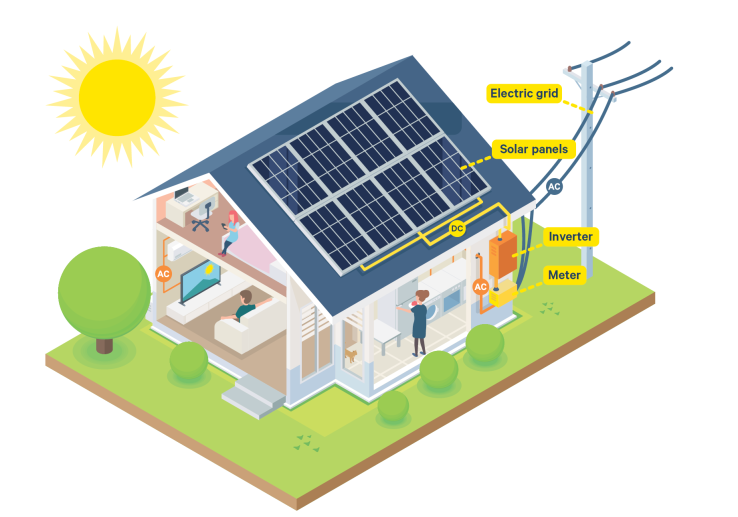Solar panels on your home
Here’s some helpful information on your solar panels and how to get the most out of them.
How your solar panels work
- The solar panels on your roof absorb energy from the sun and convert it into an electric current.
- This current flows through wires from the roof to an inverter (this is the box mounted on one of your walls).
- The inverter makes the electric current ready to use in your home and you can use it for anything that needs electricity (you won’t have to do anything differently).
- Any electricity that is not used in your home is sent back to the local electricity grid.
WARNING
Don’t touch the inverter or the wires going into it. At times they are live and you could get electrocuted.

Benefits
- You will save money on your electricity bill because the solar electricity your panels create is free for you to use.
- The amount of money you save will depend on the number of panels installed on your roof and the amount of electricity you use while the sun is shining—we estimate that you will save a few hundred dollars each year.
- Using solar energy will also reduce your home’s carbon footprint, through less fossil fuel consumption and lower greenhouse gases. That means a safer, healthier planet for everyone!
Making the most of your solar power
Try to use electricity during the day when the sun is shining. Here are a few key tips:
- Run your washing machine, your oven or other appliances during daylight hours.
- Try to shower later in the morning, so that the solar electricity can be used to heat up your hot water cylinder.
- Try to avoid using many of your appliances at the same time as you will be using more electricity than your panels are producing. When this happens, you will be charged for electricity as per normal through your electricity provider.
- If you spread the load of the electricity you use while the sun is shining, you will reduce the amount of electricity you need to pay for.
Consumer NZ(external link) has some helpful information about how much it typically costs to run your appliances.
Check out some helpful energy saving tips(external link).
Find out how much electricity your solar panels are producing
- The amount of electricity being generated is displayed on your inverter.
- If you have a standard solar installation, you can view the electricity generated over time through the Fronius Solar website or app.
- You can download the app on your computer or via the playstore or app store on your smartphone.
- If you have a Solshare system installed at your complex you will not be able to use an app as the solar is shared amongst all homes. If you would like more information on how this works, please email us at solartrials@kaingaora.govt.nz
Excess solar electricity
- If your home produces more electricity than you need, it will be sent back to the electricity grid.
- Your electricity provider may apply a small credit to your account for this excess electricity.
- It is worth checking you are on an electricity plan that credits you with a per kWh amount for any electricity sent back to the grid – you can ask your electricity provider about this.
Kāinga Ora is investigating how we can use this excess electricity to help reduce electricity bills for other customers who don’t have solar panels.
If this happens you will no longer receive a credit for excess electricity. Instead, this will go back to Kāinga Ora so we can help more customers reduce their electricity bills.
Why pre-pay electricity plans aren’t compatible with solar panels
- Homes with solar have special import-export meters installed before they can be connected to the electricity network. These import-export meters are not compatible with prepaid electricity plans.
- If you change to a prepaid electricity plan, your import-export meter will need to be disconnected and you may not be able to use the solar electricity.
- Your Housing Support Manager can help you to find a suitable electricity provider. You can also have a look at plans available on www.powerswitch.org.nz(external link).
The lifespan of your solar panels
- The solar panels will be on your house permanently, and they should last at least 25 years.
- We will monitor your solar panels for up to two years after installation. This is because we want to find out how effective they are in helping to reduce your electricity bills.
Page updated: 9 October 2023
